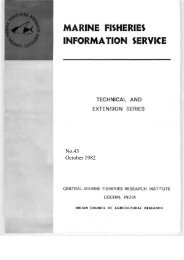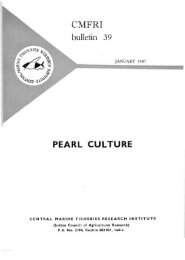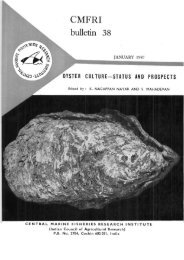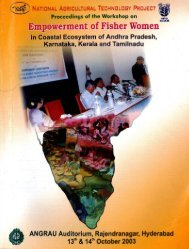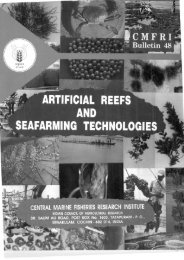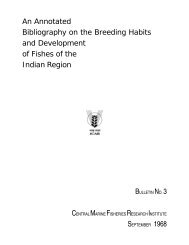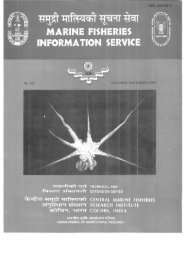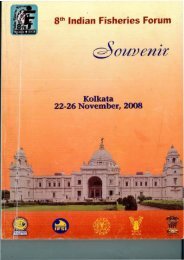bulletin 37 - Eprints@CMFRI - Central Marine Fisheries Research ...
bulletin 37 - Eprints@CMFRI - Central Marine Fisheries Research ...
bulletin 37 - Eprints@CMFRI - Central Marine Fisheries Research ...
Create successful ePaper yourself
Turn your PDF publications into a flip-book with our unique Google optimized e-Paper software.
placed in pairs over the keel. Great variations existin size and form of the nodules. The ribs on the sidesof the shell extending from the crainal knobs are lessnumerous when compared to the other species with lessbifurcation. There are two types of ribs present,the long and full sized ribs extending from the nodulesto the nucleus which are in regular alternating serieswith the secondary ones ; the latter are short and extendupto half way from the nodules. The colour of theshells varies from white with brownish black tint onthe nodules and adjacent ribs to light brown withsooty brown pigmentation over most of the surfaceof the shell (Voss and Williamson, 1971).Nautilus pompilius Linnaeus, 1758(Plate XII; C and D)Nautilus popularly known as pearly nautilus or thechambered nautilus in contrast to the other interestingremarkable cephalopod the paper nautilus Argonautais the only hving representative of the Sub Class Nautiloidea.Species of Nautilus have been described byOwen (1832), Griffin (1900), Willy (1902), Saunders(1981) and others. The remarkable feature of thepearly nautilus is its beautiful coloured external shellwhich distinguishes this from other cephalopods.Nautilus pompilius is extensively distributed in IndianOcean, Western and <strong>Central</strong> Pacific Ocean, Phillippinesto Australia and in Polynesia (Silas, 1968).The body is enclosed in an external calcareous,spirally coiled and multichambered shell. The animaloccupies the last chamber which is the largest; theinner surface of the chamber is pearly and the outersurface procellanous and pigmented wdth wavy reddishbrown bands on whitish background. The colourmarkings on the shell are very conspicuous.The successive chambers of the shell are separatedby a system of concave septa which are perforated inthe middle and a shelly tube is formed running throughthe chambers ; through this the vascular prolongationsof the tip of the mantle, the siphuncle runs. Althoughthe tubular siphuncle runs through the chambers tothe apex of the shell, it does not open into the chambers.Except the outermost recently formed chamber inwhich the body is present, all the other chambers arefilled with gas which gives buoyancy to the animal.The body of the animal consists of head whichbears eyes, a system of tentacles and a ^ac-like visceralmass. Arms are absent, funnel is bilobed. Mouth issituated at the end of the head and surrounded byfoot with two sets of lappets forming an inner and anouter circle. The edges of the circles are beset withnumerous, small, thin and annulated retractile tentacles.The tentacles are devoid of suckers and are adhesivein nature. A special fleshy hood used for closingthe last chamber as an operculum is present abovethe head region. Arms and suckers are absent. Unhkeother cephalopods Nautilus possesses two pairs of gills,two pairs of kidneys and two pairs of auricles. Sexesare separate. A portion of the tentacle crown whichinvolves four tentacles of the lappets on the right sideis modified to form the spadix.CMFRI BULLETIN <strong>37</strong> <strong>37</strong>




